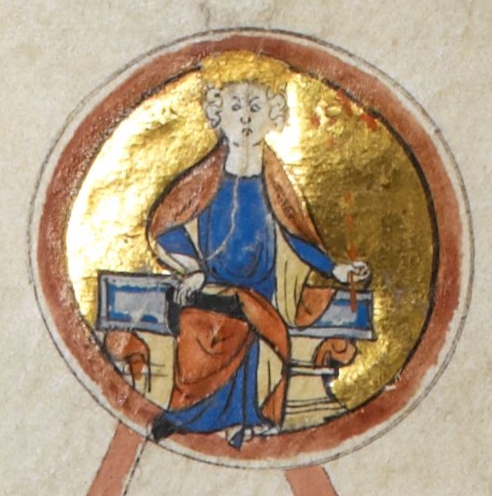by Susan Flantzer
© Unofficial Royalty 2025

Magnus the Good; Credit – By Viggo Guttorm-Pedersen – CC BY-SA 4.0, https://commons.wikimedia.org/w/index.php?curid=52039023
Magnus the Good reigned as King of Denmark from 1042 to 1047 and as King of Norway from 1035 to 1047. Born circa 1024 in Norway, Magnus was the illegitimate son of King Olaf II of Norway (later Saint Olaf) and his English concubine Alfhild, originally a slave of Olaf’s wife Queen Astrid Olofsdotter. Magnus was born prematurely and was not expected to survive. He was hastily baptized and as his father was not present at the birth, his Icelandic skald (poet) Sigvatr Þórðarson named the infant Magnus after King Olaf II’s role model, Karl Magnus (Charlemagne, King of the Franks, King of the Lombards and Emperor of the Carolingian Empire), Magnus did survive, and despite his illegitimacy, as Olaf’s only son, he was vitally important.
Magnus had one half-sister from his father’s marriage to Astrid Olofsdotter:
- Wulfhild of Norway (1020 – 1071), married Ordulf, Duke of Saxony, had a son, Magnus, Duke of Saxony

Cnut the Great, King of England, Denmark, and Norway; Credit – Wikipedia
In 1029, Cnut the Great, King of England and Denmark invaded Norway. King Olaf II and his son Magnus had been in exile since Cnut’s invasion. Eventually, they arrived in Novgorod in Kievan Rus, now in Russia, where King Olaf sought assistance from Grand Prince Yaroslav the Wise. Magnus was left to be fostered by Yaroslav and his wife Ingegerd Olofsdotter of Sweden while Olaf went to fight Cnut the Great. In 1030, King Olaf II of Norway was killed at the Battle of Stiklestad, and Cnut became King of Norway.
For the next few years, Magnus remained in Novgorod where he was educated and trained as a soldier. King Cnut sent his wife Ælfgifu of Northampton and their eldest son Sweyn Cnutsson to govern Norway. The Norwegians considered their rule oppressive and they were expelled in 1035. Eleven-year-old Magnus the Good then became King of Norway. Initially, Magnus sought revenge against his father’s enemies, but on Sigvatr Þórðarson‘s advice, he decided against it and became known as Magnus the Good.

The child kings Magnus (left) and Harthacnut meet at the Gøta River; Credit – Wikipedia
Another son of King Cnut, Harthacnut, King of Denmark and King of England (reigned 1040 – 1042), wanted Denmark to reunite with Norway, so in defense, Magnus initiated a campaign against Denmark around 1040. However, the noblemen of both countries brought the two kings together on the border between the kingdoms on the Gøta River in present-day Sweden. Magnus and Harthacnut made peace and agreed that the first to die would be succeeded by the other.

Sweyn Estridsson; fresco from the 16th century in Roskilde Cathedral in Roskilde, Denmark; Credit – Wikipedia
In 1042, Harthacnut died while in England, and Magnus became King of Denmark, despite a claim by Cnut’s nephew Sweyn Estridsson, whom Harthacnut had left in control of Denmark when he went to England. Sweyn Estridsson continued to oppose Magnus in Denmark, although they reached a settlement by which Sweyn Estridsson became Earl of Denmark under Magnus.
King Magnus wanted to reunite King Cnut’s North Sea empire by becoming King of England. When Harthacnut, King of Denmark and King of England died, his half-brother, the son of Harthacnut’s mother Emma of Normandy and her first husband Æthelred II, King of the English, now known as Saint Edward the Confessor, King of England (reigned 1042 – 1066), succeeded to the English throne. The English were mostly hostile to Magnus but Sweyn Estridsson was welcome in England.
Magnus’ uncle Harald Sigurdsson, the future King Harald III of Norway, also known as Harald Hardrada, returned to Norway and contested Magnus’ rule there. Sweyn Estridsson remained a threat in Denmark. Harald Sigurdsson allied himself with Sweyn Estridsson. King Magnus chose to appease his uncle Harald Sigurdsson and made him his co-king in Norway in 1046, and in the same year, Magnus drove Sweyn Estridsson out of Denmark.

Site of King Magnus’ grave in Nidaros Cathedral in Trondheim, Norway; Credit – By Ole Ryhl Olsson Own work, CC BY-SA 4.0, https://commons.wikimedia.org/w/index.php?curid=111711349
King Magnus was unmarried and only had one child, an illegitimate daughter. On October 25, 1047, the 24-year-old Magnus suddenly died in Denmark. The exact cause of his death is unknown but there were reports that Magnus fell overboard from a ship and drowned, that he fell off his horse, and that he fell ill while on board a ship. Magnus was buried with his father King Olaf II of Norway in Nidaros Cathedral in Trondheim, Norway. On his deathbed, Magnus named Sweyn Estridsson (King Sweyn II Estridsson, reigned 1047 – 1076) his heir in Denmark, and his uncle and co-king in Norway, Harald Hardrada (King Harald III, reigned 1046 – 1066) his heir in Norway.
This article is the intellectual property of Unofficial Royalty and is NOT TO BE COPIED, EDITED, OR POSTED IN ANY FORM ON ANOTHER WEBSITE under any circumstances. It is permissible to use a link that directs to Unofficial Royalty.
Works Cited
- Bidragsytere til Wikimedia-prosjektene. (2004). Konge av Danmark og Norge. Wikipedia.org; Wikimedia Foundation, Inc. https://no.wikipedia.org/wiki/Magnus_den_gode
- Flantzer, Susan. (2019). Cnut the Great, King of England, Denmark, and Norway. Unofficial Royalty. https://www.unofficialroyalty.com/cnut-the-great-king-of-england-denmark-and-norway/
- Flantzer, Susan. (2019). Emma of Normandy, Queen of England, Denmark and Norway. Unofficial Royalty. https://www.unofficialroyalty.com/emma-of-normandy-queen-of-england-denmark-and-norway/
- Hadley, Dawn & Richards, Julian. (2022). The Viking Great Army and the Making of England. Thames & Hudson.
- Magnus the Good. (2024). Wikipedia. https://en.wikipedia.org/wiki/Magnus_the_Good
- Wikipedia Contributors. (2019). Harald Hardrada. Wikipedia; Wikimedia Foundation. https://en.wikipedia.org/wiki/Harald_Hardrada
- Wikipedia Contributors. (2025). Saint Olaf. Wikipedia; Wikimedia Foundation.
- Wikipedia Contributors. (2025). Sweyn II of Denmark. Wikipedia; Wikimedia Foundation.
